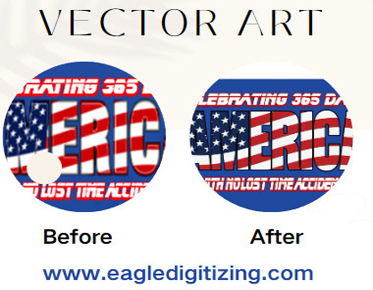Keep It Fresh: Caring for Digitized Embroidered Items Right
Embroidery is not
just a craft; it’s an art form that weaves together creativity and skill. Each
stitch tells a story, infusing life into fabrics and transforming everyday
items into cherished pieces of art. However, this beauty can fade if not cared
for properly. Caring for embroidered items is essential to ensure their
longevity and preserve their intricate designs. Understanding how to maintainthe beauty of embroidery can make all the difference, allowing you to enjoy
these treasured pieces for years to come.
Understanding the Basics of Embroidery Care
The
Lifespan of Digitized Embroidery: What to Expect
Digitized
embroidery, when executed with care, boasts impressive longevity. However, its
lifespan largely depends on the materials used, the quality of stitching, and
how well it’s cared for. High-quality thread and fabric can withstand the test
of time, remaining vibrant and intact through regular use. Typically, with the
right maintenance, embroidered items can last a decade or more, making them not
only beautiful but also a worthwhile investment.
Common
Fabrics Used in Embroidery and Their Care Needs
Different fabrics
possess distinct care requirements. Cotton, a popular choice, is durable and
easy to maintain, usually responding well to regular washing. Silk, on the
other hand, demands gentler treatment due to its delicate nature. Linen can
withstand wear but needs careful washing to prevent shrinking. Understanding
the unique properties of these fabrics is crucial to preserving the integrity
of the embroidery.
The
Impact of Environmental Factors on Embroidery Longevity
Environmental
factors play a significant role in the lifespan of embroidered items. Sunlight
can cause colors to fade, while humidity can lead to mold growth. Dust
accumulation can dull the fabric’s sheen, and excessive heat may weaken fibers.
Awareness of these factors and taking preventive measures can help maintain the
vibrancy and quality of your embroidery.
Washing Your Embroidered Items
The
Best Practices for Washing Embroidered Fabrics
To maintain the
beauty of embroidered items, washing them properly is essential. Start by
turning the fabric inside out to protect the stitches from friction. Use cold
water to prevent shrinkage and color bleeding, and opt for a gentle cycle if
using a machine. Air drying is recommended to avoid heat damage.
Hand
Washing vs. Machine Washing: Pros and Cons
Hand washing
offers the gentlest care, making it ideal for delicate fabrics like silk or
intricate embroidery. This method allows for meticulous attention to any stains
or marks. However, it can be time-consuming. Machine washing, while convenient,
carries the risk of agitation and damage. For most embroidered items, a gentle
cycle with cold water can be a safe compromise.
How
to Choose the Right Detergent for Embroidered Items
Selecting the
right detergent is vital. Avoid harsh chemicals that may degrade threads or
fade colors. Look for mild detergents specifically designed for delicate
fabrics. Enzyme-free and phosphate-free options are typically gentler and
effective for maintaining the integrity of the embroidery.
Drying Techniques for Embroidered Products
Air
Drying: The Safest Method for Embroidery
Air drying is the
safest technique for embroidered items. Lay them flat on a clean, dry towel to
absorb moisture, or hang them on a hanger away from direct sunlight. This
method prevents heat-related damage and helps maintain the fabric's shape.
Using
a Dryer: What to Consider Before Tossing It In
If using a dryer
is necessary, be mindful. Employ a low-heat setting and remove the item while
still slightly damp to avoid over-drying. It’s advisable to check the care
label beforehand, as some fabrics are not dryer-safe.
How
to Properly Iron Embroidered Items
Ironing
embroidered items requires caution. Always use a low heat setting and place a
thin cloth over the embroidery to prevent direct contact with the iron. This
protects the stitches from flattening or melting. Steam can also be a friend
here, helping to ease out wrinkles without direct pressure.
Storing Embroidered Items Safely
Tips
for Storing Embroidered Clothes to Avoid Damage
When storing
embroidered items, cleanliness is paramount. Before storing them, make sure
they are well-cleaned and dry. Avoid folding them over the embroidery to
prevent creasing and potential damage.
The
Best Storage Solutions: Bins, Hangers, and More
Opt for
breathable fabric storage bins or acid-free tissue paper for delicate items.
Wooden hangers can be a good choice for garments, as they maintain shape.
Plastic covers should be avoided since they might retain moisture and encourage
mildew.
How
to Prevent Dust and Moisture from Affecting Embroidery
Dust is an
inevitable enemy of beautifully embroidered pieces. Covering them with a soft
cotton sheet can help, as can keeping them in a cool, dry place. Regularly
check your storage area for any signs of moisture, and consider using silica
gel packs to absorb excess humidity.
Dealing with Stains
Quick
Action: How to Treat Stains on Embroidered Fabrics
When a stain
strikes, swift action is crucial. Blot—not rub—the stain gently with a clean
cloth to absorb excess liquid. Rinse with cold water, and if necessary, apply a
suitable stain remover that’s safe for the fabric type.
Homemade
Stain Removers: Natural Solutions for Tough Spots
For those who
prefer natural solutions, homemade stain removers can be effective. A mixture
of white vinegar and water can tackle many stains, while baking soda can work
wonders for grease. Always check for colorfastness by doing a small, discrete
area test first.
Preventing
Stains: Tips for Everyday Use
Preventing stains
is far easier than removing them. Be mindful of where you place your
embroidered items—keep them away from food and drinks. Regularly inspecting
them for potential stains can also help catch issues before they become
permanent.
Maintaining Thread Quality
Understanding
Thread Types and Their Care Requirements
Different threads
require different care. Polyester threads are generally more durable than
cotton, resisting fading and fraying. Understanding the thread type used in
your embroidery can guide you in its maintenance, ensuring your designs remain
vibrant and intact.
How
to Check for Fraying and What to Do About It
Regularly inspect
embroidered items for signs of fraying. If you notice loose threads, carefully
trim them with sharp scissors. For larger areas of concern, consider
re-stitching to reinforce the design and prevent further damage.
Tips
for Refreshing Your Embroidered Items
To refresh your
embroidered items, gently brush the fabric with a soft bristle brush to lift
any dust or dirt. Light steaming can also help to reinvigorate the fabric and
restore its original texture.
Preserving Color Vibrancy
The
Best Practices for Keeping Colors Bright
To keep your
embroidery looking fresh, avoid exposing it to direct sunlight for extended
periods, as UV rays can fade colors. Store items in a dark, cool place to
minimize color loss. Regular gentle cleaning also helps to maintain vibrancy.
How
Sunlight Affects Embroidery Colors and What to Do
Sunlight can
significantly alter the appearance of colors in embroidery, especially bright
hues. To combat this, consider using UV-blocking curtains or shades in display
areas. Rotating items regularly can also prevent uneven fading.
Washing
Tips to Maintain Color Integrity
Washing
embroidered items properly is essential to maintaining color integrity. Always
use cold water, and avoid bleach, which can strip colors. For colored items,
consider washing them with similar colors to prevent bleeding.
Repairing Damaged Embroidery
Common
Embroidery Issues and How to Fix Them
Embroidery may
experience various issues, from loose threads to unraveling stitches.
Identifying these problems early is crucial. For small gaps, re-stitching is
often sufficient, while larger areas may require more extensive repair.
When
to Re-Stitch: Signs That Repairs Are Needed
If stitches are
noticeably loose or missing, it’s time to re-stitch. Regular inspections can
help catch these issues early. Additionally, if the fabric shows signs of wear
around the embroidery, addressing these concerns promptly can prevent further
damage.
Tools
and Techniques for DIY Embroidery Repair
A few simple
tools can make repairing embroidery manageable. Sharp scissors, embroidery
needles, and matching thread are essential for re-stitching. Learning basic
embroidery techniques, like the backstitch or running stitch, can empower you
to tackle minor repairs effectively.
Custom Embroidery Items: Extra Care
Understanding
the Unique Needs of Custom Pieces
Custom embroidery
often involves unique fabrics and designs, each with specific care
requirements. Understanding these needs is vital to preserving the integrity
and beauty of custom pieces.
How
to Handle Specialty Fabrics in Custom Embroidery
Specialty
fabrics, such as velvet or faux leather, require delicate handling. For these
materials, always follow specific care instructions and use the gentlest
cleaning methods. Testing any cleaning solutions on a small area first is a
prudent approach.
Long-Term
Care for Custom Embroidered Gifts
Customembroidered gifts are often treasured items. To ensure they remain in pristine
condition, educate recipients on proper care. Providing care instructions with
the gift can enhance its longevity and value.
Tips for Professional Care
When
to Consider Professional Cleaning Services
Certain items,
especially those made from delicate or specialty fabrics, may benefit from
professional cleaning. If an item is heavily soiled or you’re unsure how to
care for it, seeking expert help can prevent further damage.
Finding
a Reliable Cleaner for Embroidered Items
When selecting a
professional cleaner, look for specialists experienced in handling embroidered
items. Check reviews and ask for recommendations to ensure quality service.
Questions
to Ask Before Hiring a Cleaning Professional
Before entrusting
your embroidered items to a cleaner, inquire about their experience with
similar fabrics. Find out how they clean and if they provide any guarantees for
their services. This due diligence will help you find a trustworthy
professional.
Creating an Embroidery Care Routine
Building
a Care Schedule for Your Embroidered Items
Establishing a
care routine is a proactive approach to maintaining your embroidered items.
Schedule regular inspections, washing, and storing tasks to ensure they remain
in excellent condition.
Daily,
Weekly, and Monthly Care Tips
Daily care may
include gentle dusting or brushing to remove particles. Weekly checks for
stains or loose threads can catch issues early. Monthly deep cleaning and
inspection ensure ongoing maintenance.
How
to Teach Family and Friends to Care for Embroidery
Educating family
and friends about embroidery care can help preserve shared items. Create a
simple guide outlining essential care steps, making it easier for everyone to
contribute to maintaining these beautiful pieces.
Maintaining and caring for digitized embroidered items is a rewarding endeavor that enhances their beauty and longevity. By understanding the intricacies of fabric care, washing techniques, and proper storage methods, embroidered items can remain vibrant and cherished for generations. Embroidery is more than just a decorative art; it’s a testament to craftsmanship and creativity. With careful attention and love, your embroidered treasures can continue to inspire and delight. Embrace the journey of preserving the beauty of your embroidery, and let each piece shine in its full glory.



